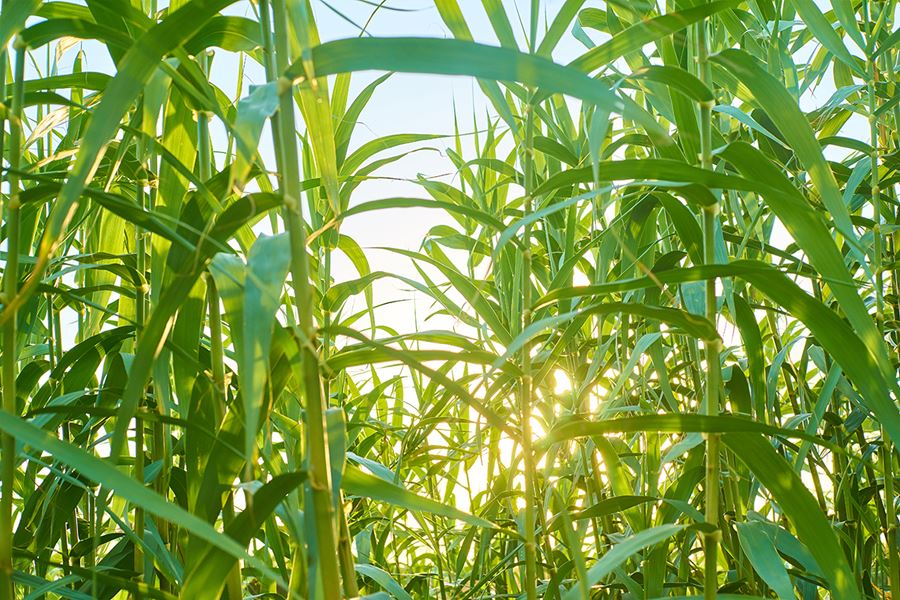Bio-based plastics
Bio-based plastics can be defined as polymer produced from renewable resources, mainly crops – in whole or partly. It is therefore an alternative to conventional plastics based on fossil resources. Bio-based plastics can either be biodegradable (in specified environments) or non-biodegradable.

In the non-degradable category, we have ‘drop-in’ bio-based plastics which have identical chemical structure as their fossil-based counterpart e.g., bio-PET. These drop-ins are easier to process in the existing recycling systems than the bio-based plastics which have a chemical structure like no other. They are called ”novel bio-based plastics”.
The general environmental benefit of bio-based plastics comes from the shift from fossil feedstock to bio-based feedstock. Renewable resources constitute a temporary removal of greenhouse gases (basically CO2) from the atmosphere. This carbon fixation can be extended for a longer period of time if the material is recycled (e.g ‘drop-in’ bio-based plastics). For both bio-based and fossil-based plastics, if not reused, the highest environmental gain is obtained by recycling it into new plastic products.
The renewable resources used in bio-based plastics have predominantly been crops such as corn, cereals, sugar beets or sugar cane. There is also ongoing research and development on second and third generation feedstock (see definitions of feedstock generations below). However, there is a risk that shifting from fossil to bio-based materials may create new environmental problems. The use of renewable resources has an environmental impact too, such as large cultivation areas needed, land use change and impact on biodiversity e.g., if forest is converted into agricultural land. Above all, the first generation feedstock is not only needed for plastics, it competes with food production.
How does the Nordic Swan Ecolabel contribute?
For plastics, the Nordic Swan Ecolabel requirements in general promotes bio-based raw materials over virgin fossil-based when possible and strive to make sure that this shift does not create new environmental problems. For bio-based feedstock, use of secondary raw materials such as residuals from other productions (e.g., bagasse from sugar cane) and recycled raw materials are in general promoted over primary raw materials. The requirements are, however, often related to a specific raw material and product group in question. In addition, sustainable sourced bio-based plastics that can be reused or recycled to new plastic products are prioritized over bio-based plastics that are bio-degradable.
Where relevant, the requirements for the Nordic Swan Ecolabel for plastics are set for:
- Plastic feedstock in general, a high share of sustainable raw materials in a product – either recycled or bio-based materials that can be reused or recycled.
- Bio-based feedstock – primary raw materials: a certification according to credible third-party standards and certification schemes that follow certain principles, such as:
- Manufacturers must respect international laws and conventions.
- The standard has absolute requirements for environmental, economic and social sustainability.
- The standard is developed in a transparent process where stakeholders participate.
- An independent third-party verifies that the products and the company meet the standards’ requirements.
- Bio-based feedstock – secondary raw materials: waste or residual products defined in accordance with (EU) Renewable Energy Directive 2018/2001. There must be traceability back to the production / process where the residual production occurred.
- Bio-based feedstock – recycled raw materials: Recycled material (according to ISO 14021) documentation for that the raw material is recycled.
- Restrictions on the use of certain raw materials that are not produced or sourced in a sustainable way.
- Traceability (often certified traceability) of raw material for ensuring that the bio-based plastics is sustainably sourced and traceable. The raw material supply chain is documented all the way from the site of extraction until final product.
- Recyclability: bio-based plasticsmust be recyclable via the existing waste systems operating in the Nordic region. Incineration with energy recovery is not considered as material recovery.
Definitions
First generation feedstock are crops and plants that can be consumed by humans and animals.
Second generation feedstock refers to crops and plants not suitable for human consumption (food) or animal consumption (feed). Second generation feedstock can be either non-food crops (cellulosic feedstock) or waste materials from first generation feedstock (e.g., waste vegetable oil). Examples of second generation feedstock include: wood, short-rotation crops such as poplar, willow or miscanthus (elephant grass), wheat straw, bagasse, corncobs, palm fruit bunches and switch grass.
Third generation feedstock is biomass derived from algae.